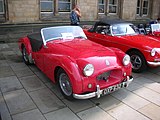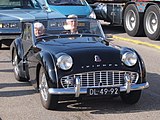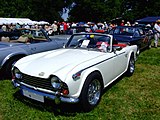Triumph TR

The Triumph TR range of cars was built between 1953 and 1981 by the
Concept car predecessors
TR-X
| Triumph TR-X Roadster | ||
|---|---|---|
| Overview | ||
| Manufacturer | Triumph Motor Company (1945) | |
| Also called | "Bullet" Kerb weight 1,168 kg (23 long cwt)[4] | |
| Chronology | ||
| Predecessor | Triumph Roadster | |
| Successor | Triumph 20TS | |
The Triumph TR-X, also known as the "Bullet",
The TR-X was discontinued after three prototypes had been built.
20TS
Sir John Black, chairman of Standard-Triumph, was determined to have a sports car to compete with Morgan, which he had earlier tried to buy. Black ordered the design of a sports car using existing chassis, suspension, and engine, and inexpensive bodywork. Other design objectives were a price of approximately £500 and a top speed of at least 90 mph.[7][10]
The resulting car, the
Production TRs
TR2 and TR3
The redesign and development of the 20TS led to a longer, roomier car with a larger boot, built on an all-new frame with revised suspension and brakes and an uprated engine. The resulting
The TR3, introduced in 1955, had a front grille and a more powerful engine. In October 1956, the front brakes of the TR3 were changed from 10 in drums to 11 in discs. The TR3 was restyled in 1957 and was available with a larger 2.2 litre; engine;[13] the restyled car was unofficially known as the TR3A.[14] A further development, with the larger engine as standard and with a fully synchromesh gearbox, was made available in 1962, the final year of TR3 production.[13] This last version of the TR3 was unofficially known as the TR3B.[citation needed]
-
Triumph TR3 with narrow grille.
-
Later TR3 with wide grille.
TR4, TR4A, TR5, TR250, and TR6
Introduced in 1961, the TR4 had a completely new body designed by Giovanni Michelotti.[15] The TR4 was upgraded to the TR4A in 1965 with the addition of independent rear suspension.[16]
In 1967, the TR line was updated with servo-assisted brakes and a 2.5 L version of the
Both the TR250 and the TR5 were replaced by the TR6 in 1968, with the US version continuing with carburettors.[17] The main difference between the TR6 and the TR5 it replaced was its styling. The front and rear ends of the car had been restyled by German coachbuilder Karmann, giving the car a more contemporary appearance.[17] An anti-roll bar was added to the front suspension as well.[18]
-
Michelotti-designed TR4.
-
Triumph TR5 engine.
-
Triumph TR250, US market version of the TR5.
TR7 and TR8
The Triumph TR7 was introduced in 1974. While all previous TRs were evolutionary designs developed from the TR2, the TR7 was an all-new design owing nothing but its model designation to the earlier TRs. While the TR7's unit body and wedge shape were advertised by Leyland as major improvements, these were offset by the TR7's return to a four-cylinder engine and a live rear axle.[19]
The TR7 was initially available as a coupé, with a convertible version being developed after the launch of the coupé. A premium-grade version using the Rover V8 engine was developed as part of the same project. The TR7 convertible was introduced in 1979.[citation needed] Also introduced in 1979 was the Triumph TR8, a premium V8 version of the TR7.[17]
The TR7 and TR8 were discontinued in 1981.[17]
-
Triumph TR7 hardtop.
-
Triumph TR8 hardtop.
Notes
- ^ a b c Langworth 1973, p. 130.
- ^ a b c d Robson 2011, p. 133.
- ^ a b c d e f g h Langworth 1973, p. 131.
- ^ a b c d e f Culshaw & Horrobin 2013, p. 318.
- ^ a b c d e f Lawrence 1996, p. 302.
- ^ a b Cook 2001, pp. 24–26.
- ^ a b c d e f g Krause & Krause 1998, p. [page needed]
- ^ Robson 2011, pp. 133–134.
- ^ a b c d Robson 2011, p. 134.
- ^ a b Langworth 1973, p. 133.
- ^ a b Langworth 1973, p. 134.
- ^ Elliott 2007, p. 101.
- ^ a b Elliott 2007, p. 103.
- ^ Piggott 2009, p. 139.
- ^ Elliott 2007, p. 104.
- ^ Elliott 2007, pp. 103, 104.
- ^ a b c d e Elliott 2007, p. 105.
- ^ Elliott 2007, pp. 105, 106.
- ^ Elliott 2007, p. 108.
References
- Cook, Michael (2001). "Chapter 3: Birth of the "TR"". Triumph Cars in America (illustrated ed.). MotorBooks International. pp. 24–33. ISBN 9780760301654. Retrieved 28 April 2012.
- Culshaw, David; Horrobin, Peter (2013) [1974]. "Triumph". The Complete Catalogue of British Cars 1895 - 1975 (e-book ed.). Poundbury, Dorchester, UK: Veloce Publishing. pp. 315–322. ISBN 978-1-845845-83-4.
- Elliott, James (March 2007). Elliott, James (ed.). "The Magic Numbers". Classic & Sports Car. 25 (12). Teddington, Middlesex, UK: Haymarket Publishing: 100–109. ISSN 0263-3183.
- Krause, G. William; Krause, Bill (1998). Triumph Sports Cars. Enthusiast Color (illustrated ed.). MotorBooks International. ISBN 9780760304501. Retrieved 29 April 2012.
- LCCN 62004005.
- Lawrence, Mike (1996) [1991]. "Triumph (GB)". A to Z of Sports Cars 1945-1990 (Paperback ed.). Bay View Books. ISBN 1-870979-81-8. Retrieved 13 October 2014.
- Piggott, Bill (2009). Collector's Originality Guide Triumph TR2 TR3 TR4 TR5 TR6 TR7 TR8. MBI Publishing. ISBN 978-0-7603-3576-5.
- Robson, Graham (May 2011). The Book of the Standard Motor Company. Poundbury, Dorchester, UK: Veloce Publishing. ISBN 978-1-845843-43-4. Retrieved 11 June 2013.









